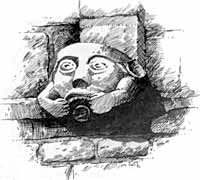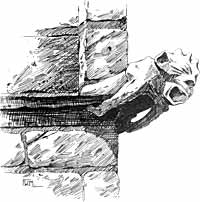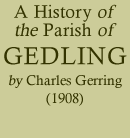< Previous | Contents | Next >

Screen.
A very handsome and chaste chancel screen of carved oak was completed the week before Christmas, 1905. It was dedicated on Sunday evening, January 14th, 1906, by Bishop Hamilton Baynes, Vicar of St. Mary's, Nottingham. On a brass rail inside the gates is the following inscription:—
"To the Honour and Glory of God and in loving memory of George Blackburn, J.P., Alderman of the City of Nottingham, this screen was erected by his sons, William Henry, Benjamin Fielding, and Richard, 1905."
The style of the work is the same as the screen now in the Tower Arch, and is in character with the later work of the building, and is in the same style as the east window of the north aisle. It ornaments the Church generally, and shows the proportions of the chancel to advantage.
The inventory of Church Goods belonging to the parish of Gedling, drawn up in .the reign of King Edward the Sixth (1552), is preserved in the Record Office, London. The following is a copy of the same:—
"Thys ys the inventory of all and synguler the goods of the churche of gedlyng wryttyng the XVIII daye of Septembre in the sext yere of the Reyng of owr sufferane lorde Edwarde the sext by the grace of god of England france & Ireland Kyng defendor of the faythe and of the churche of Enguland and allso of Ireland sup'me heade
| henry holdnay | } | bryan wakar | |
| wyllm parkar | } | churche wardyns | Jhon caryngton |
| Jhon barnys | |||
| Parrsesheonars |
Inp'ms iiij bells a sanct8 belle A hand belle a sacryn bell It a chalys wt a patyne of sylvr a crosse of copper a crosse of brasse amylyd ij lattyne candylsteks It a payre of sensors of lattyn ij cruytts It a westament of blake sylke one of rede sylke wth albs It a cowpe of Rede veluet a laur of lattyne It iij to wells iij altr clothys ij corpraxe wtcovryngs It a cryssu' stoke of metalle and a pyxe of coper
Goods longyne to the chapyle of stoke
Inp'ms one vestment of rede sylke wt a albe It a lyttylle belle
| H. Rutland | ||
| G. Pierpoint | ||
| A. Nevyll | Jon Hercy" |
The Church Plate now in use consists of a flagon, cup, and paten. The flagon and cup are silver. On the flagon are the Arms of Emmanuel College, Cambridge, and the inscription :—
Joannes Sudbury,
Nuper Decan Dunelm.
Ricardo Kirkby.
A.B. Coll. Emman.
1734.
AIEN APISTEUEIN
And on the cup is Ar. two bars, gu. and in a canton of the second a Cross Moline Or, for Kirkby. On the lid is a Cap of State, surmounted by a cabled circle containing a Cross Moline Or.
There are some collecting plates and a paten, all old pewter, bearing the following marks:—One bears a rose, another an eagle displayed, another a plough, and another a sinister hand holding an arrow. Some of the shields are surmounted by a Royal Crown, and the word "London."
Two of the plates are marked, one with a "G," and the other with a "C." These used to be held at the Church door at collections, the parishioners of Gedling claiming the contents of the plate marked "G," and the parishioners of Carlton (who at this time worshipped at Gedling) claiming the contents of the plate marked "C." The practice was discontinued about 1870.
The following notes must conclude our account of the church:—
In 1294, Thomas de Kirkcudbright was consecrated, at Gedling Church, Bishop of Witherne, in succession to Henry, the late Bishop, who died 1 November 1293. On 13 January 1294, John, King of Scotland, wrote to John Romanus, Archbishop of York, about Thomas de Kirkcudbright, chaplain of Robert Bruce, who had been elected bishop by John, prior of Witherne, and his convent. On May 30, 1294, the new prelate made his profession of obedience to Romanus, and the Bishops of Carlisle and St. Asaph were asked to assist at his consecration, which took place at Gedling, "die dom. in crast. B. Dionisii, 1294." (Raine, Fasti Eboracenses, p. 332.)
While Lord Forester was Rector of Gedling he caused the names and years of institution of the Rectors and Vicars of Gedling, together with the names and dates of the Archbishops of York, to be painted on the interior of the lower stage of the tower, now used as a Vestry.
The following reminiscences of Gedling, by an old parishioner, written in 1904, and dating back 65 years are now of much interest. "Then the gallery was at the west end, with organ and mixed choir (led by Miss Williams, daughter of the Rector), and a few seats for parishioners; the entrance was by stairs at south side. There were old-fashioned pews in nave and chancel, and there sat people not only from Gedling and Stoke, but also from Carlton and Netherfield (at that time consisting of very few cottages). In the chancel was Lord Chesterfield's pew, filled on Sunday afternoons during the shooting season. On one afternoon "The Oratorio" was rendered, and collection made for the "Lying-in" charity pertaining to this parish. In those days the "three decker" stood where the lectern now stands, and over the pulpit was a sounding board which, at the restoration of the Church, was made into a table and placed in the Rectory; and is now in the Chapter House in Southwell Cathedral. The Clergyman robed within the Communion Rails, changed his surplice there for the black gown when he had to preach; the clerk (Horsley) assisted him. Horsley was also master of the school, then situate on the right hand side of the road midway between the Church and the present station. The Clerk gave out the Hymns, and the congregation turned to the west during the singing. The Sunday School children sat on low forms placed in the middle of the aisle, and sat back to back. The present vestry was used by the bell ringers only. The bell was tolled at 8 o'clock a.m. if there were to be morning prayers, and if prayers in afternoon, then the bell was tolled at 12 o'clock."
 |
 |
|
| Gargoyles. S. Aisle. Gedling Church. | ||
